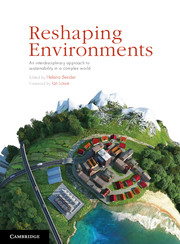Book contents
- Frontmatter
- Contents
- Contributors
- Acknowledgements
- Introduction Reshaping environments – an opportunity for envisioning the future
- Part 1 Cases
- Part 2 Skills
- Part 3 Theory
- 13 Conceptualising change
- 14 Sustainability
- 15 Human needs and norms
- 16 Conceptualising and thinking about environmental systems
- 17 Why scale matters
- Index
- Plate Section
- References
14 - Sustainability
A model for the future
from Part 3 - Theory
Published online by Cambridge University Press: 05 February 2013
- Frontmatter
- Contents
- Contributors
- Acknowledgements
- Introduction Reshaping environments – an opportunity for envisioning the future
- Part 1 Cases
- Part 2 Skills
- Part 3 Theory
- 13 Conceptualising change
- 14 Sustainability
- 15 Human needs and norms
- 16 Conceptualising and thinking about environmental systems
- 17 Why scale matters
- Index
- Plate Section
- References
Summary
Introduction
In the classic story The Time Machine by H. G. Wells (1895) a 19th century adventurer creates a machine that can travel into the past and the future. At the start of exploring what is possible with this new creation the character is caught up in the excitement of discovery. What was the past like? What does the future hold? As the plot progresses there is an awakening to the realisation that each action that the adventurer takes, intentional or not, has implications for the future.
Sustainability is widely used as a guide to a more desirable future. It continues to increase in popularity as an ideal underpinning decision-making, but there is still no agreement on the usage of the term. In part this is because authors writing on sustainability make a choice between thinking of sustainability as a theoretical concept and thinking of it as a practice, or way of life. This chapter considers sustainability to be both of these things, and that both are important partners in understanding and acting responsibly in the world. Practice needs to be underpinned by and respond to theory. The theory is rooted in observations of and reflections about how humans want to act in relationship with the Earth’s systems, and as a theory needs to be critically revised. There is an extensive literature on how to practice sustainability, but it is harder to find accessible discussion of the theoretical concept. Thus, this chapter explores the theory and, to a small extent, the practice of sustainability as a concept that links past, present and future and offers a model to all adventurers on the planet Earth.
- Type
- Chapter
- Information
- Reshaping EnvironmentsAn Interdisciplinary Approach to Sustainability in a Complex World, pp. 305 - 334Publisher: Cambridge University PressPrint publication year: 2012
References
- 1
- Cited by



